Effects of Local Vegetation and Regional Controls in Near-Surface Air Temperature for Southeastern Brazil
Abstract
1. Introduction
2. Materials And Methods
2.1. Weather Station Information
2.2. Statistical Model
3. Results and Discussion
3.1. Model Fitting
3.2. Regional Range of Gam Parameters
3.3. Seasonality of Gam Response
3.4. Impact of Land Use Heterogeneity in Urban Areas
4. Conclusions
Supplementary Materials
Author Contributions
Funding
Institutional Review Board Statement
Informed Consent Statement
Data Availability Statement
Acknowledgments
Conflicts of Interest
References
- Gulev, S.; Thorne, P.; Ahn, J.; Dentener, F.; Domingues, C.; Gong, S.G.D.; Kaufman, D.; Nnamchi, H.; Rivera, J.Q.J.; Sathyendranath, S.; et al. Changing state of the climate system. In Climate Change 2021: The Physical Science Basis: Working Group I Contribution to the Sixth Assessment Report of the Intergovernmental Panel on Climate Change; Allan, R., Collins, B., Eds.; Cambridge University Press: Cambridge, UK, 2021. [Google Scholar]
- Doblas-Reyes, F.J.; Sorensson, A.A.; Almazroui, M.; Dosio, A.; Gutowski, W.J.; Haarsma, R.; Hamdi, R.; Hewitson, B.; Kwon, W.T.; Lamptey, B.L.; et al. Linking global to regional climate change. In Climate Change 2021: The Physical Science Basis. Contribution of Working Group I to the Sixth Assessment Report of the Intergovernmental Panel on Climate Change; Masson-Delmotte, V., Zhai, P., Pirani, A., Connors, S.L., Pean, C., Berger, S., Caud, N., Chen, Y., Goldfarb, L., Gomis, M.I., et al., Eds.; Cambridge University Press: Cambridge, UK, 2021. [Google Scholar]
- de Abreu, R.; Tett, S.; Schurer, A.; Rocha, H. Attribution of Detected Temperature Trends in Southeast Brazil. Geophys. Res. Lett. 2019, 46, 8407–8414. [Google Scholar] [CrossRef]
- Jones, P.; Lister, D.; Osborn, T.; Harpham, C.; Salmon, M.; Morice, C. Hemispheric and large-scale land-surface air temperature variations: An extensive revision and an update to 2010. J. Geophys. Res. Atmos. 2012, 117, 1–29. [Google Scholar] [CrossRef]
- Bindoff, N.; Stott, P.; AchutaRao, K.; Allen, M.; Gillett, N.; Gutzler, D.; Hansingo, K.; Hegerl, G.; Hu, Y.; Jain, S.; et al. Detection and Attribution of Climate Change: From Global to Regional. In Climate Change 2013: The Physical Science Basis. Contribution of Working Group I to the Fifth Assessment Report of the Intergovernmental Panel on Climate Change; Stocker, T., Qin, D., Plattner, G.K., Tignor, M., Allen, S., Boschung, J., Nauels, A., Xia, Y., Bex, V., Midgley, P., Eds.; Cambridge University Press: Cambridge, UK; New York, NY, USA, 2013; Book Section 10; pp. 867–952. [Google Scholar] [CrossRef]
- Blain, G.C.; Picoli, M.C.A.; Lulu, J. Análises estatísticas das tendências de elevação nas séries anuais de temperatura mínima do ar no Estado de São Paulo. Bragantia 2009, 68, 807–815. [Google Scholar] [CrossRef]
- Marengo, J.A. Mudanças climáticas globais e regionais: Avaliação do clima atual do Brasil e projeções de cenários climáticos do futuro. Rev. Bras. Meteorol. 2001, 16, 1–18. [Google Scholar]
- Camilloni, I.; Barros, V. On the urban heat island effect dependence on temperature trends. Clim. Chang. 1997, 37, 665–681. [Google Scholar] [CrossRef]
- Kalnay, E.; Cai, M. Impact of urbanization and land-use change on climate. Nature 2003, 423, 528–531. [Google Scholar] [CrossRef]
- Wang, J.; Yan, Z.W. Urbanization-related warming in local temperature records: A review. Atmos. Ocean. Sci. Lett. 2016, 9, 129–138. [Google Scholar] [CrossRef]
- Ceppi, P.; Scherrer, S.C.; Fischer, A.M.; Appenzeller, C. Revisiting Swiss temperature trends 1959–2008. Int. J. Climatol. 2012, 32, 203–213. [Google Scholar] [CrossRef]
- Kagawa-Viviani, A.; Giambelluca, T. Spatial patterns and trends in surface air temperatures and implied changes in atmospheric moisture across the Hawaiian Islands, 1905–2017. J. Geophys. Res. Atmos. 2020, 125, e2019JD031571. [Google Scholar] [CrossRef]
- Hunt, J.D.; Stilpen, D.; de Freitas, M.A.V. A review of the causes, impacts and solutions for electricity supply crises in Brazil. Renew. Sustain. Energy Rev. 2018, 88, 208–222. [Google Scholar] [CrossRef]
- Nobre, C.; Young, A.F.; Saldiva, P.H.N.; Orsini, J.A.M.; Nobre, A.D.; Ogura, A.T.; Thomaz, O.; Párraga, G.O.O.; da Silva, G.C.M.; Valverde, M.; et al. Vulnerability of Brazilian megacities to climate change: The São Paulo Metropolitan Region (RMSP). In Climate Change in Brazil: Economic, Social and Regulatory Aspects; Motta, R.S., Hargrave, J., Luedemann, G., Gutierrez, M.B.S., Eds.; IPEA: Brasília, Brazil, 2011. [Google Scholar]
- Pereira, V.R.; Blain, G.C.; Avila, A.M.H.d.; Pires, R.C.d.M.; Pinto, H.S. Impacts of climate change on drought: Changes to drier conditions at the beginning of the crop growing season in southern Brazil. Bragantia 2017, 77, 201–211. [Google Scholar] [CrossRef]
- Alvares, C.A.; Stape, J.L.; Sentelhas, P.C.; de Moraes Gonçalves, J.L. Modeling monthly mean air temperature for Brazil. Theor. Appl. Climatol. 2013, 113, 407–427. [Google Scholar] [CrossRef]
- Rodríguez-Lado, L.; Sparovek, G.; Vidal-Torrado, P.; Dourado-Neto, D.; Macías-Vázquez, F. Modelling air temperature for the state of São Paulo, Brazil. Sci. Agric. 2007, 64, 460–467. [Google Scholar] [CrossRef][Green Version]
- Silva Dias, M.A.; Vidale, P.L.; Blanco, C.M. Case study and numerical simulation of the summer regional circulation in São Paulo, Brazil. Bound.-Layer Meteorol. 1995, 74, 371–388. [Google Scholar] [CrossRef]
- Oke, T.R.; Mills, G.; Voogt, J. Urban Climates; Cambridge University Press: Cambridge, UK, 2017. [Google Scholar]
- Silva Dias, M.A.; Dias, J.; Carvalho, L.M.; Freitas, E.D.; Silva Dias, P.L. Changes in extreme daily rainfall for São Paulo, Brazil. Clim. Chang. 2013, 116, 705–722. [Google Scholar] [CrossRef]
- Zhao, L.; Lee, X.; Smith, R.B.; Oleson, K. Strong contributions of local background climate to urban heat islands. Nature 2014, 511, 216–219. [Google Scholar] [CrossRef] [PubMed]
- Manoli, G.; Fatichi, S.; Schläpfer, M.; Yu, K.; Crowther, T.W.; Meili, N.; Burlando, P.; Katul, G.G.; Bou-Zeid, E. Magnitude of urban heat islands largely explained by climate and population. Nature 2019, 573, 55–60. [Google Scholar] [CrossRef]
- Sun, R.; Zhang, B. Topographic effects on spatial pattern of surface air temperature in complex mountain environment. Environ. Earth Sci. 2016, 75, 621. [Google Scholar] [CrossRef]
- Wood, S.N. Generalized Additive Models: An Introduction with R; CRC Press: Boca Raton, FL, USA, 2017. [Google Scholar]
- WMO. A Note on Climatological Normals; Technical Report; World Meteorological Organization: Geneva, Switzerland, 1967. [Google Scholar]
- WMO. Guide to Instruments and Methods of Observation: Volume I—Measurement of Meteorological Variables; Technical Report; World Meteorological Organization: Geneva, Switzerland, 2018. [Google Scholar]
- Meek, D.; Hatfield, J. Data quality checking for single station meteorological databases. Agric. For. Meteorol. 1994, 69, 85–109. [Google Scholar] [CrossRef]
- Shafer, M.A.; Fiebrich, C.A.; Arndt, D.S.; Fredrickson, S.E.; Hughes, T.W. Quality assurance procedures in the Oklahoma Mesonetwork. J. Atmos. Ocean. Technol. 2000, 17, 474–494. [Google Scholar] [CrossRef]
- Beckers, J.M.; Rixen, M. EOF calculations and data filling from incomplete oceanographic datasets. J. Atmos. Ocean. Technol. 2003, 20, 1839–1856. [Google Scholar] [CrossRef]
- Henn, B.; Raleigh, M.S.; Fisher, A.; Lundquist, J.D. A comparison of methods for filling gaps in hourly near-surface air temperature data. J. Hydrometeorol. 2013, 14, 929–945. [Google Scholar] [CrossRef]
- Farr, T.G.; Rosen, P.A.; Caro, E.; Crippen, R.; Duren, R.; Hensley, S.; Kobrick, M.; Paller, M.; Rodriguez, E.; Roth, L.; et al. The shuttle radar topography mission. Rev. Geophys. 2007, 45, 1–33. [Google Scholar] [CrossRef]
- Wilson, A.M.; Jetz, W. Remotely sensed high-resolution global cloud dynamics for predicting ecosystem and biodiversity distributions. PLoS Biol. 2016, 14, e1002415. [Google Scholar] [CrossRef]
- Hastie, T.; Tibshirani, R.; Friedman, J. The Elements of Statistical Learning: Data Mining, Inference, and Prediction; Springer: Berlin/Heidelberg, Germany, 2009. [Google Scholar]
- Neter, J.; Kutner, M.H.; Nachtsheim, C.J.; Wasserman, W. Applied Linear Statistical Models; McGraw-Hill Irwin: Boston, MA, USA, 2005; Volume 5. [Google Scholar]
- Martin, T.C.; da Rocha, H.R.; Joly, C.A.; Freitas, H.C.; Wanderley, R.L.; da Silva, J.M. Fine-scale climate variability in a complex terrain basin using a high-resolution weather station network in southeastern Brazil. Int. J. Climatol. 2019, 39, 218–234. [Google Scholar] [CrossRef]
- Oliveira, A.P.d.; Silva Dias, P.L.d. Aspectos observacionais da brisa marítima em São Paulo. In II CBM: Anais 1980–2006; Sociedade Brasileira de Meteorologia: Rio de Janeiro, Brazil, 1982. [Google Scholar]
- Li, Y.; Zeng, Z.; Zhao, L.; Piao, S. Spatial patterns of climatological temperature lapse rate in mainland China: A multi–time scale investigation. J. Geophys. Res. Atmos. 2015, 120, 2661–2675. [Google Scholar] [CrossRef]
- Wallace, J.M.; Hobbs, P.V. Atmospheric Science: An Introductory Survey; Elsevier: Amsterdam, The Netherlands, 2006; Volume 92. [Google Scholar]
- Kirchner, M.; Faus-Kessler, T.; Jakobi, G.; Leuchner, M.; Ries, L.; Scheel, H.E.; Suppan, P. Altitudinal temperature lapse rates in an Alpine valley: Trends and the influence of season and weather patterns. Int. J. Climatol. 2013, 33, 539–555. [Google Scholar] [CrossRef]
- Wanderley, R.L.; Domingues, L.M.; Joly, C.A.; da Rocha, H.R. Relationship between land surface temperature and fraction of anthropized area in the Atlantic forest region, Brazil. PLoS ONE 2019, 14, e0225443. [Google Scholar] [CrossRef] [PubMed]
- Lambin, E.F.; Ehrlich, D. The surface temperature-vegetation index space for land cover and land-cover change analysis. Int. J. Remote. Sens. 1996, 17, 463–487. [Google Scholar] [CrossRef]
- Bhang, K.J. Anomalous variations of NDVI for a nonvegetated urban industrial area of Gumi, Korea. Am. J. Remote Sens. 2014, 2, 44–49. [Google Scholar] [CrossRef][Green Version]
- Reboita, M.S.; Gan, M.A.; Rocha, R.P.d.; Ambrizzi, T. Regimes de precipitação na América do Sul: Uma revisão bibliográfica. Rev. Bras. Meteorol. 2010, 25, 185–204. [Google Scholar] [CrossRef]
- Hicks, B.B.; Callahan, W.J.; Hoekzema, M.A. On the heat islands of Washington, DC, and New York City, NY. Bound.-Layer Meteorol. 2010, 135, 291–300. [Google Scholar] [CrossRef]
- Suomi, J.; Hjort, J.; Käyhkö, J. Effects of scale on modelling the urban heat island in Turku, SW Finland. Clim. Res. 2012, 55, 105–118. [Google Scholar] [CrossRef]
- Stewart, I.D. A systematic review and scientific critique of methodology in modern urban heat island literature. Int. J. Climatol. 2011, 31, 200–217. [Google Scholar] [CrossRef]
- Wang, J.; Tett, S.; Yan, Z. Correcting urban bias in large-scale temperature records in China, 1980–2009. Geophys. Res. Lett. 2017, 44, 401–408. [Google Scholar] [CrossRef]
- Cao, W.; Huang, L.; Liu, L.; Zhai, J.; Wu, D. Overestimating impacts of urbanization on regional temperatures in developing megacity: Beijing as an example. Adv. Meteorol. 2019, 2019, 3985715. [Google Scholar] [CrossRef]
- Stewart, I.D.; Oke, T.R. Local climate zones for urban temperature studies. Bull. Am. Meteorol. Soc. 2012, 93, 1879–1900. [Google Scholar] [CrossRef]
- Mallick, S.K.; Das, P.; Maity, B.; Rudra, S.; Pramanik, M.; Pradhan, B.; Sahana, M. Understanding future urban growth, urban resilience and sustainable development of small cities using prediction-adaptation-resilience (PAR) approach. Sustain. Cities Soc. 2021, 74, 103196. [Google Scholar] [CrossRef]
- McClymont, K.; Cunha, D.G.F.; Maidment, C.; Ashagre, B.; Vasconcelos, A.F.; de Macedo, M.B.; Dos Santos, M.F.N.; Júnior, M.N.G.; Mendiondo, E.M.; Barbassa, A.P.; et al. Towards urban resilience through Sustainable Drainage Systems: A multi-objective optimisation problem. J. Environ. Manag. 2020, 275, 111173. [Google Scholar] [CrossRef]
- Wijngaard, J.B.; Klein Tank, A.M.G.; Können, G.P. Homogeneity of 20th century European daily temperature and precipitation series. Int. J. Climatol. 2003, 23, 679–692. [Google Scholar] [CrossRef]
- Alexandersson, H.; Moberg, A. Homogenization of Swedish temperature data. Part I: Homogeneity test for linear trends. Int. J. Climatol. 1997, 17, 25–34. [Google Scholar] [CrossRef]
- Pettit, A.N. A non-parametric approach to the change-point problem. Appl. Stat. 1979, 28, 126–135. [Google Scholar] [CrossRef]
- Verstraeten, G.; Poesen, J.; Demarée, G.; Salles, C. Long-term (105 years) variability in rain erosivity as derived from 10-min rainfall depth data for Ukkel (Brussels, Belgium): Implications for assessing soil erosion rates. J. Geophys. Res. Atmos. 2006, 111, 1–11. [Google Scholar] [CrossRef]
- El Kenawy, A.; López-Moreno, J.I.; Stepanek, P.; Vicente-Serrano, S.M. An assessment of the role of homogenization protocol in the performance of daily temperature series and trends: Application to northeastern Spain. Int. J. Climatol. 2013, 33, 87–108. [Google Scholar] [CrossRef]
- Menne, M.J.; Williams, C.N., Jr. Homogenization of temperature series via pairwise comparisons. J. Clim. 2009, 22, 1700–1717. [Google Scholar] [CrossRef]
- Xavier, A.C.; King, C.W.; Scanlon, B.R. Daily gridded meteorological variables in Brazil (1980–2013). Int. J. Climatol. 2016, 36, 2644–2659. [Google Scholar] [CrossRef]
- Souza, C.M., Jr.; Shimbo, J.Z.; Rosa, M.R.; Parente, L.L.; Alencar, A.A.; Rudorff, B.F.; Hasenack, H.; Matsumoto, M.; Ferreira, L.G.; Souza-Filho, P.W.; et al. Reconstructing three decades of land use and land cover changes in brazilian biomes with landsat archive and earth engine. Remote Sens. 2020, 12, 2735. [Google Scholar] [CrossRef]

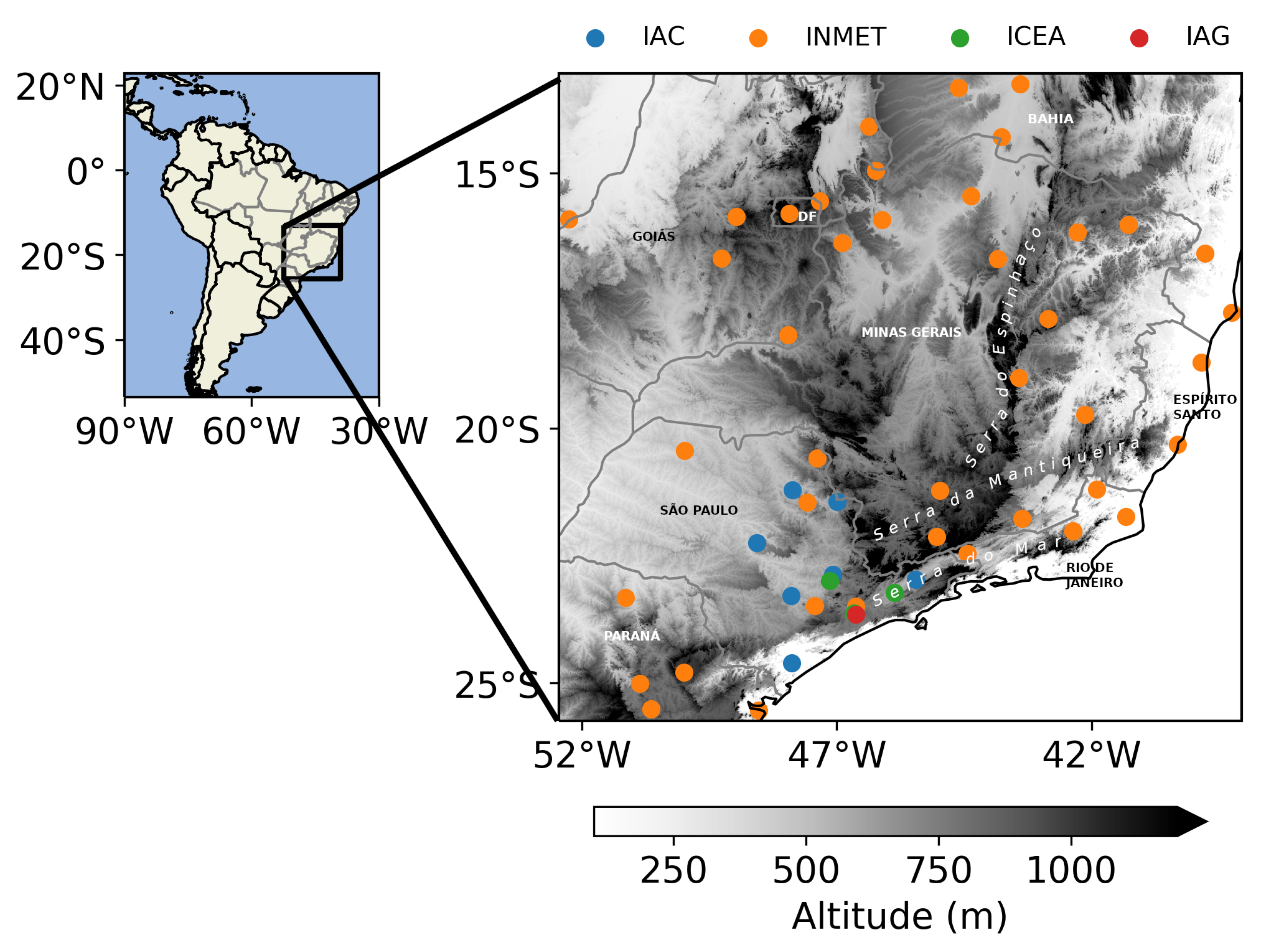

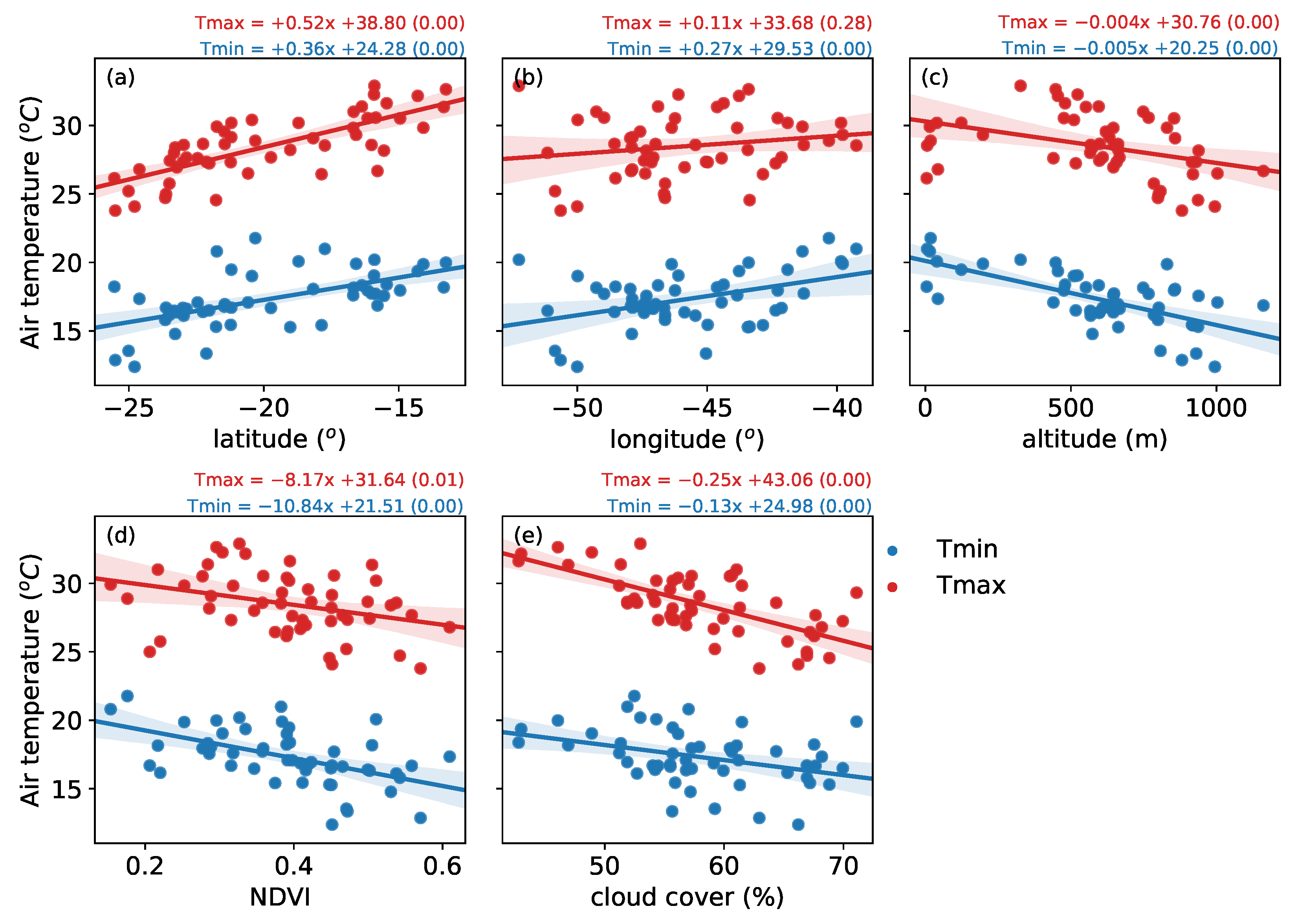
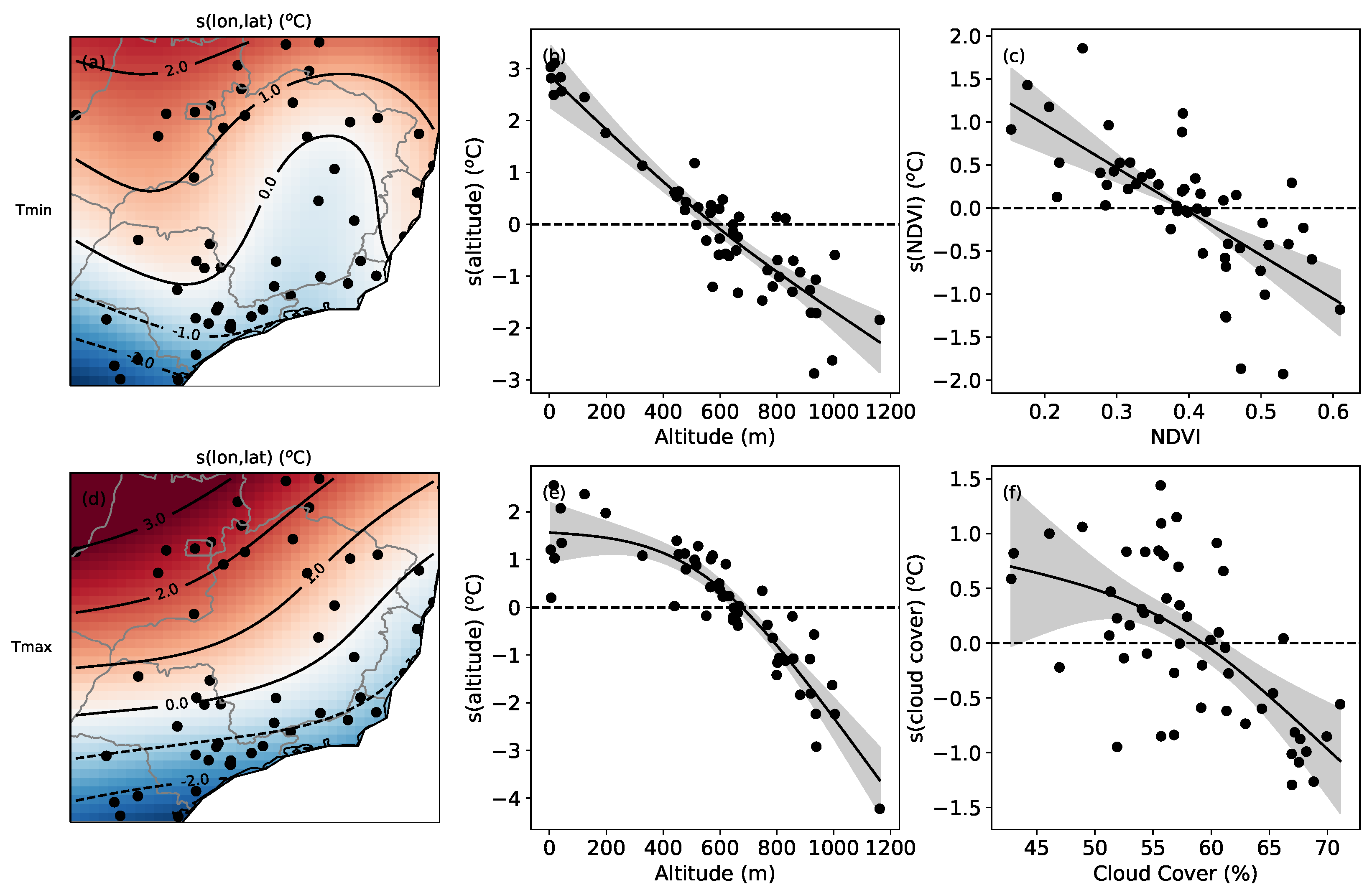
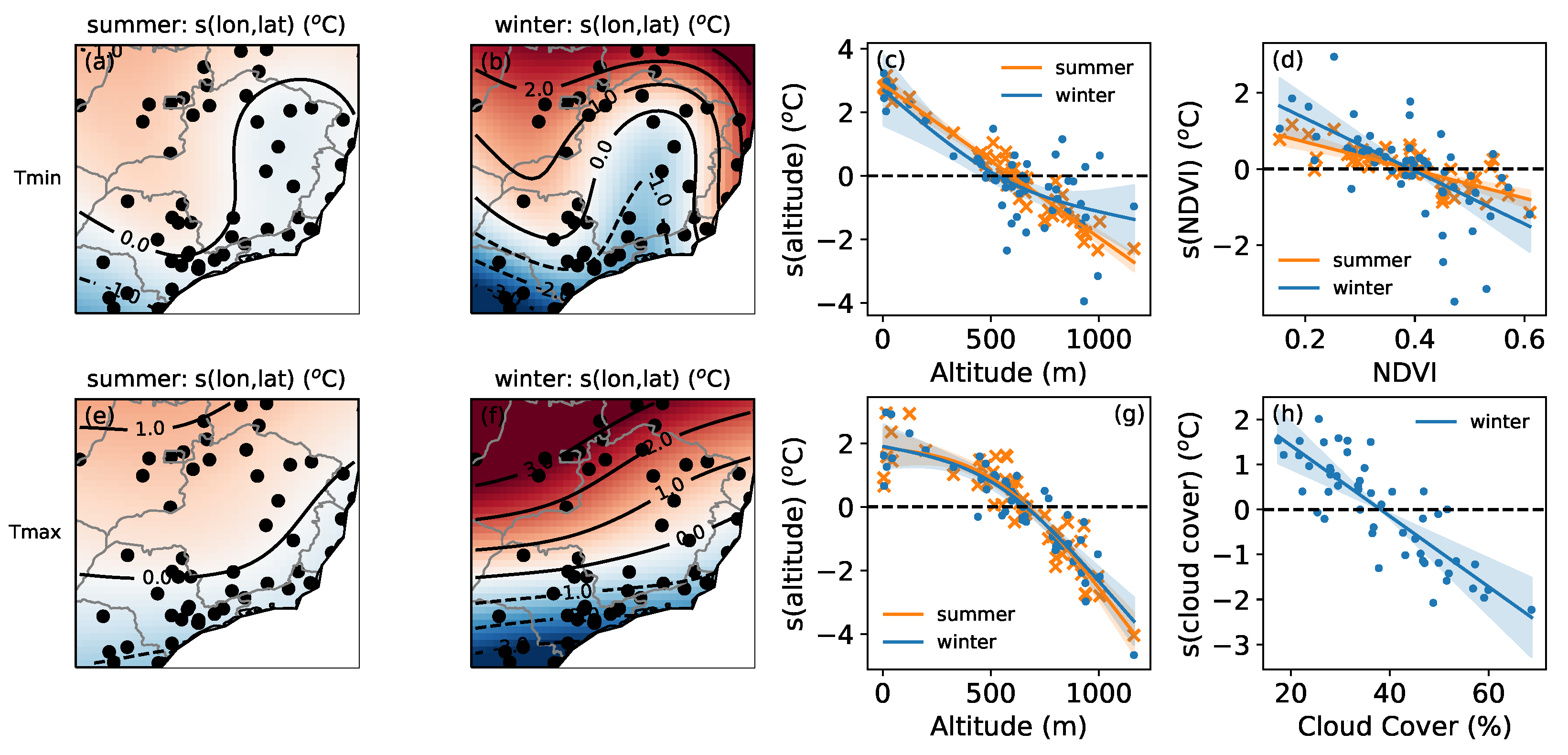

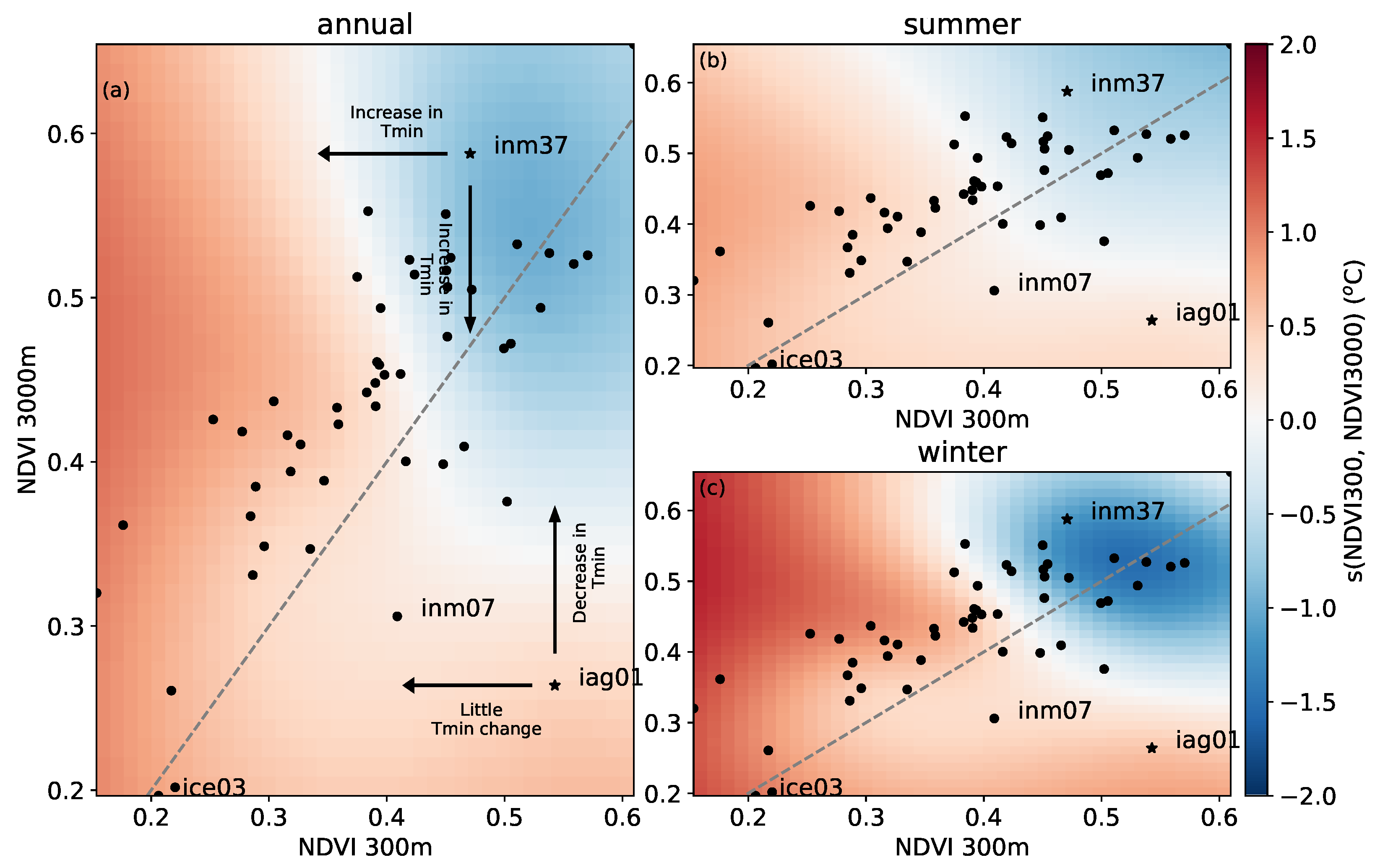
| Generalized Additive Model (GAM) | Multiple Linear Regression (MLR) | ||||
|---|---|---|---|---|---|
| Tmax (edf) | Tmin (edf) | Tmax | Tmin | ||
| Intercept | 28.5 | 17.3 | Intercept | 37.5 | 27.5 |
| - | - | - | lon | −0.17 | - |
| s(lon,lat) | 5.40 | 7.71 | lat | 0.44 | 0.26 |
| s(altitude) | 1.95 | 1.55 | altitude | −0.003 | −0.005 |
| s(NDVI) | - | 1.00 | NDVI | - | −6.04 |
| s(cloud cover) | 1.56 | - | cloud cover | −0.10 | - |
| R2 | 94.3% | 93.4% | R2 | 85.8% | 86.1% |
| BIC | 125.8 | 127.2 | BIC | 155.4 | 136.4 |
Publisher’s Note: MDPI stays neutral with regard to jurisdictional claims in published maps and institutional affiliations. |
© 2022 by the authors. Licensee MDPI, Basel, Switzerland. This article is an open access article distributed under the terms and conditions of the Creative Commons Attribution (CC BY) license (https://creativecommons.org/licenses/by/4.0/).
Share and Cite
de Abreu, R.C.; Hallak, R.; da Rocha, H.R. Effects of Local Vegetation and Regional Controls in Near-Surface Air Temperature for Southeastern Brazil. Atmosphere 2022, 13, 1758. https://doi.org/10.3390/atmos13111758
de Abreu RC, Hallak R, da Rocha HR. Effects of Local Vegetation and Regional Controls in Near-Surface Air Temperature for Southeastern Brazil. Atmosphere. 2022; 13(11):1758. https://doi.org/10.3390/atmos13111758
Chicago/Turabian Stylede Abreu, Rafael Cesario, Ricardo Hallak, and Humberto Ribeiro da Rocha. 2022. "Effects of Local Vegetation and Regional Controls in Near-Surface Air Temperature for Southeastern Brazil" Atmosphere 13, no. 11: 1758. https://doi.org/10.3390/atmos13111758
APA Stylede Abreu, R. C., Hallak, R., & da Rocha, H. R. (2022). Effects of Local Vegetation and Regional Controls in Near-Surface Air Temperature for Southeastern Brazil. Atmosphere, 13(11), 1758. https://doi.org/10.3390/atmos13111758






